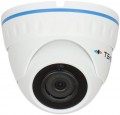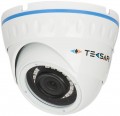Number of LEDs
The number of backlight LEDs (see "Design and capabilities") provided in the camera design.
Theoretically, more LEDs provide more power and, accordingly, range (see below) and efficiency
of IR illumination or LED illumination. However, in fact, such light sources can vary markedly in performance; in addition, a lot also depends on the features of the camera itself. Therefore, in fact, this indicator is a reference, and when choosing, it makes sense to pay attention to parameters that are closer to practice — in particular, the same backlight range (see below).
Model
Model of the matrix installed in the surveillance camera. Knowing the exact name of the model, you can find detailed information about its operation — from detailed specifications to real user reviews — and assess how this option meets your requirements.
Matrix size
The size of the matrix installed in the surveillance camera (diagonally).
In general, larger sensors (with the same resolution and sensor type) are considered more advanced: they get more light, which has a positive effect on image quality (especially in low light). On the other hand, increasing the size affects the cost of the entire device; and in some cases (for example, if the camera is not planned to be used in twilight and darkness), a relatively small sensor may be quite suitable.
As for specific dimensions, the most modest cameras in terms of this indicator have matrices of
1/4 "or less. Models with sensors of
1/3.8" - 1/3" and
1/2.9" - 1/2" are very popular, these values can be called average. And in advanced devices, diagonals and
more than 1/2 "(up to 1/1.7") are found.
Number of megapixels
Camera sensor resolution in megapixels (millions of pixels).
The higher the resolution of the matrix, the higher the video resolution can be (see below), the more detailed the image is capable of providing the camera. At the same time, note that as the number of megapixels increases (without changing the size of the matrix), the size of each individual pixel decreases, which increases the likelihood of noise and deterioration in the overall image quality. Therefore, high resolution in itself is not necessarily a sign of high quality — a lot depends on other things, for example, on the size of the matrix (see above).
As for specific values, in the most modest matrices it does not exceed 1.3 MP, which corresponds to the maximum
HD resolution.
2 MP sensors allow for already Full HD resolution (usually 1920x1080 or 1600x1200),
3 MP,
4 MP,
5 MP and
6 MP are capable of better resolution, but still do not reach
4K, which is typical for 8 MP.
Video resolution
The maximum video resolution that the camera can capture.
The higher the resolution of the video, the more details you can see on it, the less details will be blurry. On the other hand, high resolution means large volumes of video materials, which, accordingly, requires capacious media for their storage and fast communication channels for broadcasting video in real time. Yes, and this indicator significantly affects the cost of the camera.
Aperture
Aperture of the lens installed in the camera.
Aperture characterizes the degree of attenuation of the light flux when passing from the front lens of the lens to the matrix. It is denoted as the ratio of the diameter of the active aperture of the lens to the focal length, while the size of the active aperture is designated as f and is taken as a unit — for example, f / 1.4 or f / 2.0. Moreover, the smaller the number in the designation, the higher the aperture (in our example, the second lens will be darker than the first). And for lenses with a variable focal length (see "Focal"), the actual aperture, usually, changes with a change in focal length; for such models, either the range of aperture values, or its maximum value, can be indicated.
By itself, this parameter characterizes, first of all, how light the image taken through the lens turns out, all other things being equal. High values are important, first of all, when shooting in low light conditions: a fast lens allows you to get a fairly high-quality image without increasing the sensitivity of the matrix, which is fraught with noise and “blurring” of the picture. On the other hand, the actual quality of camera operation (including in dark conditions) also depends on many other factors — the type and size of the matrix, signal processing features, etc. Therefore, aperture in most cases is more of a reference than a practically significant parameter.
Backlight compensation
—
WDR (Wide Dynamic Range) — extended dynamic range. WDR technology combines several frames with different exposures into one picture, as a result, dark areas are brightened, and overexposures are darkened, and the output is a picture with extremely uniform lighting. The true wide dynamic range technology is called True-WDR and it is implemented in the optical circuit at the hardware level, a special microprocessor is responsible for creating and mixing exposures. A more affordable alternative to wide dynamic range is Digital-WDR technology, which equalizes lighting through software algorithms.
—
DWDR (Digital Wide Dynamic Range) — extended dynamic range technology based on software brightening algorithms. DWDR brightens too dark areas of the frame, which can be completely blurred against the background of light areas. Digital brightening allows you to noticeably improve the quality of shooting in contrasting lighting conditions. Digital WDR cameras are noticeably cheaper than true True-WDR optics. Of course, the quality of digital brightening is inferior to True-WDR.
—
BLC (Back Light Compensation) — backlight compensation technology. This system is based on the work of digital signal processors DSP. So, the device, relatively speaking, "breaks" the frame into many segments, making its own adjustments to each of them. Backlight compensation brightens dark areas of
...the frame well. The main disadvantage of the technology is the increase in the brightness of the already bright areas of the frame, due to which overexposure may appear in the picture.
— WDR+BLC. The camcorder supports several lightening technologies at once, each of which is described in more detail above. Immediately, we note that the combination of WDR + BLC allows you to achieve an extremely clear and clear picture in almost any lighting conditions, from extreme contrast to insufficient and excessively bright.
— DWDR+BLC. The device supports two popular clarification technologies at once, each of which is described in more detail above. The presence of DWDR + BLC technologies allows the camera to effectively brighten the dark areas of the frame. Such video cameras have proven themselves well when working in low light conditions.Operating temperature
The ambient temperature range in which the camera can be used normally.
All modern surveillance cameras normally tolerate temperatures typical for houses / apartments, offices and other premises with similar mild conditions. Therefore, it is worth paying attention to this parameter, first of all, if the device is planned to be used outdoors — or in a room where the temperature does not differ much from the street temperature or, for technical reasons, should be low (freezer warehouse, refrigerated car, etc. ). In such cases, the lower temperature threshold is especially important: for example, almost all outdoor cameras have the ability to work
in cold temperatures below 0 °, but among indoor models such features are much less common. However,
frost-resistant devices(with an allowable temperature of -40 °C and below) can also be found not only among outdoor cameras, but also among “internal” cameras.
As for the upper temperature limit, it is usually not lower than +40 °C, which is quite enough for using the camera in a temperate climate. In some models, this limit reaches +50 °C and even +60 °C, making them suitable even for hot countries. However, note that we are talking exclusively about use in the shade; the possibility of working under direct sunlight should be clarified separately.
Material
The main material used in the construction of the camera body.
— Plastic. Inexpensive and at the same time quite practical material. Plastic is light, quite strong (not as strong as metal, but still quite sufficient for most cases), chemically inert (and therefore not susceptible to corrosion and insensitive to moisture), and also has a relatively low thermal conductivity (which provides additional protection for extreme temperature fluctuations). Due to all this, this material is very popular in indoor chambers (see "Usage"). At the same time, it is somewhat less suitable for outdoor work.
— Metal. The main advantage of metal, in comparison with plastic, in the case of surveillance cameras is high strength and reliability. This allows you to use it even for street models that work in difficult conditions and must have a certain anti-vandal resistance (at least not immediately “give up” when trying to break or break). At the same time, such material is much more expensive, and therefore less common.

